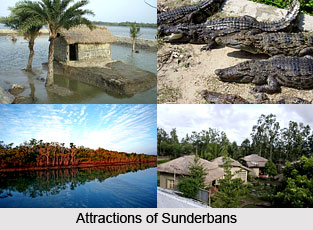 Sunderbans are considered to be a part the world`s largest delta, is well known by its vast stretch of mangrove forest, which is thick with different varieties of trees. Sunderbans are geographically located on the lower end of the Gangetic West Bengal, lying within the latitude between 21 degree and 13 minutes to 22 degrees and 40 minutes North and longitude 88 degree and 5minutes-89 degree and 06 minutes East. This is the place where the land meets the sea at the southern end of the state of West Bengal. Extensive mounds and land obstruct the natural drainage in the upstream area, other than the main river channels. The Sundarbans comprises of rivers that are basically confluence of salt water and freshwater. Thus this region is a blend of freshwater from the rivers originating from the Ganga River and the saline water from Bay of Bengal.
Sunderbans are considered to be a part the world`s largest delta, is well known by its vast stretch of mangrove forest, which is thick with different varieties of trees. Sunderbans are geographically located on the lower end of the Gangetic West Bengal, lying within the latitude between 21 degree and 13 minutes to 22 degrees and 40 minutes North and longitude 88 degree and 5minutes-89 degree and 06 minutes East. This is the place where the land meets the sea at the southern end of the state of West Bengal. Extensive mounds and land obstruct the natural drainage in the upstream area, other than the main river channels. The Sundarbans comprises of rivers that are basically confluence of salt water and freshwater. Thus this region is a blend of freshwater from the rivers originating from the Ganga River and the saline water from Bay of Bengal.
As mentioned, Sunderbans is spread over an expanse of 4262 square kms in India alone, with a larger portion in Bangladesh. Indian part of the Sunderbans has 2,125 sq km of the area being covered by mangrove forest. This again extends over across 56 islands, the balance being under saline water, which flows through the abundant tidal channels and creeks. This area, which is 2585 sq. kms, is the home of tigers and other fauna, forming the largest Tiger Reserve and National Park in India. This place is very widely visited though it is highly secluded from the civilization. The area is very not at all inviting and congenial, but fraught with danger. Being dangerous it provides for the ultimate adventure that one looks for in this beautiful jungle as it literally means in Bengali Language. In these areas, birding is somewhat not suitable not just due to the difficult terrain but also the concentration of the birds, which is not clear from a very restricted view of the noisy boat. The only access to the land after one reaches the park is at the Sajnekhali compound along with the different Watchtowers. Hence these are also places that one can visit apart from the jungle. "Sundar" means beautiful and the forest is retains its beauty even in its wilderness, which appeals to many nature loving people. Other etymology attached with it is that due to the profusion of the Sundari trees here, the place is called so.

In the year 1911, it was described as `a tract of waste country`, which had no account of its belongings in the historical context. That time the vast tract of land extended about 165 miles from the opening of the Hugli to the mouth of the Meghna, and was delimited internally by the three settled districts of the 24 Parganas, Khulna and Backergunje. Hugli and Meghna are the names by which the Ganges is known at different places. The total area it stretched for was estimated at 6526 square miles including water. This area was basically a water-clogged forest, trees originating in water, which was fringed with tigers, and other wild animals. The most characteristic tree of the forest was the sundari tree (Heritiera littoralis). This tree generates a hard wood that is usually used for building purposes, like making boats, furniture and other articles.
A very complex network of tidal waterways crosses the Sunderbans, along with the numerous small islands of salt-tolerant mangrove forests, presenting an excellent paradigm of ongoing ecological processes. Genwa, Dhundal, Passur, Garjan and Kankra, impenetrable Goran trees between 1.8 mtr and 3.6 meter high covers almost the entire region. Sunderbans has a remarkable reserve of wildlife, the man-eating Royal Bengal Tigers to be the most famous among them. Apart form this, various species of birds and spotted deer, crocodiles and snakes also find a shelter in the jungle. This area is believed to be the home of an estimated 400 Bengal tigers and about 30,000 spotted deer. These tigers are ferocious and well known for the number of people they kill. These man-eating tigers are killing around 100-250 people per year. They live in the close limitations of the humans but then there are many who live in such close proximity without harming them. Several cases have been reported where these tigers have attacked the humans, this also makes it dangerous for the visitors who have no other choice but abide by the rules and stay within the confines of the protected place and avoid the danger prone areas. Attacks by the tigers have also engaged men in survival fights against the beast. This shows at what length they struggle for existence and the hostile surroundings that are not suited for free existence. There are many causes which induces the tiger to attack on humans, some of them are that the non-availability of fresh water and the predominance of salty water, which made it aggressive. The salty water is not fit for drinking which have frustrated the beast. During high tides, the tiger`s odour is destroyed; this is an important sign for the territory of the tiger. When this fades away, the tiger tries to defend its territory by physically subjugating them. Reasons like the tiger getting used to the flesh of the humans after the dead bodies float out in the swampy water, humans being an easy prey, etc cannot be ignored either. Apart from the tigers and other animals, the mangrove forest being so thick and impenetrable provides shelter and hiding place for most attractive species of birds. These birds are unique in this category falls the a Grey Headed Lapwing, Brown-winged Kingfisher, a Pallas`s Fish Eagle, a Lesser Adjutant or maybe a Mangrove Whistler, which is a very rare sight for the travellers.
In order to prevent tiger attacks, steps have been taken up by the local inhabitants and government officials. How much effective these measures are, that has doubts. Since only a few work in favour of them. Bonbibi is their goddess who is evoked through prayers and offerings before they set our on expeditions, or even to save them from the tigers and other dangers. Invocations to the tiger god Daskin Ray (pronounced "DOCK-shin ROY") is also a major task that the people perform when they have to go for some important job through the jungle. Apart from these, in order to avoid any attack from their back, they wear masks on the back of their heads. For some time this mechanism worked but then the tigers realized it and then were no more subdued by it. In order to prevent the tigers from biting into the spine, which is their favoured attack method, the Government officials wear stiff pads that rise up the back of the neck. These can indicate one simple thing that the tigers are a major threat to the people and protection from them has been a major issue.
The monsoons are outrageous and like the rest of the coastal areas, the delta is also submerged. These areas come under its effect and sediment of the lower delta plain is largely transported inland by monsoon coastal system and cyclonic events. The threat of rising sea levels has been engulfing the people living in the delta region.
Sunderbans is a contrast to the other mangrove forests due to its huge biodiversity, and is designated as UNESCO`s World Network of International Biosphere Reserves since 2001. The forest is vastly protective and productive, always contributing to the country`s economy. The forest has an outstanding characteristic, which is the bayonet like roots of mangrove forests that stick out above the water level. Therefore large reserve of the mangroves that sustain on water, this delta region is hostile and unapproachable to certain extent. The Sunderbans have been capturing the limelight in the recent years, since a lot of steps to encourage tourism have been taken up. This is an amazing adventurous place that has the charm of the wilderness mixed with thrill of the all-encompassing man-eater.






